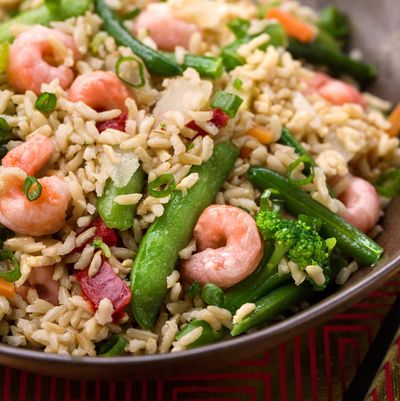
The dinner table of the future may be all vegetable burgers that bleed, vegan eggs, and fake shrimp made of algae, all optimally cooked thanks to Innit. Americans love shrimp, now the United States’ seafood of choice, but eating them — especially the cheap, pre-peeled variety — is problematic. Forced labor is rampant in Thailand’s shrimping industry, and shrimp farmed by sea slaves have been sold by major American grocers and restaurants including Whole Foods, Costco, Nestle, Red Lobster, and Walmart. And that’s not to mention the devastating issues of overfishing and pollution, which some scientists gravely predict could result in “fishless oceans” as soon as 2050. A solution may be on the horizon, though, courtesy of a San Francisco biotech company called New Wave Foods, an entrant in the emerging, increasingly competitive fake-food market.
Founded a little over a year ago by Dominique Barnes, who studied marine conservation at the Scripps Institution of Oceanography, and Michelle Wolf, a materials scientist, the company originally focused on creating fake shark fins. But New Wave turned its focus to shrimp when Barnes and Wolf realized the market for shark fin wasn’t big enough. It turned out to be a smart move, as in September San Francisco “accelerator” IndieBio accepted New Wave into its fold of synthetic-biotech start-ups.
So what are fake shrimp made of if not, well, shrimp? Composed of broken-down red algae, a food actual prawns eat, and plant-based protein powder, it’s made through a process that Barnes describes to The Atlantic as “similar to baking a loaf of bread.” New Waves promises its faux shrimp not only look like real shrimp but also mimic the seafood’s elasticity and fishy flavor. Barnes and Wolf certainly sound committed to getting it right, telling Tech Insider they’ve “analyzed shrimp on a molecular level.”
Of course, the only way to get most people to actually eat this fake shrimp is to make it actually taste good and like the real thing. Whether New Wave succeeds depends on this, but at least one early word is good. A Tech Insider writer claims the texture is “almost perfect” and that she could see herself subbing it in for the real thing if the situation was right. And Google is apparently curious, having placed a 200-pound order.
It won’t be that long before you’re able to find out for yourself. New Wave’s first product, pre-breaded popcorn shrimp, will debut in about eight months. Its ultimate ambition and challenge, though, is to sell a “naked” shrimp that doesn’t hide its true face. The company’s founders are aware of the uphill climb they’ll face in convincing Americans to eat algae, but if you’re going to start somewhere, you might as well go with the easy sell of deep-fried food coated in starch.
[Atlantic]





